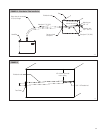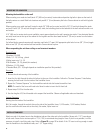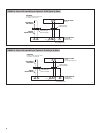
DISTRIBUTION TUBE INSTALLATION
After the location for the distribution tube has been identified, follow the steps below and refer to Figure 12 to install the
distribution tube in the duct.
1. Cut or drill a 1 5/8” diameter opening in the duct.
2. Drill a 3/8” hole in the opposite surface of the duct so that the distribution tube has a 2”/ft. (15%) pitch, sloping back towards
the humidifier. The distribution tube is to be positioned in the duct such that 1 1/2” – 3 1/2” of the tube is extending out of the
duct for attachment of the steam hose.
3. Use a 3/8”-16 mounting bolt (included) to secure the end of the tube to the far side of the duct.
4. If the duct is wider than the distribution tube, attach a 3/8”-16 threaded rod cut to the appropriate length (not provided) to the
end of the tube. Secure end of threaded rod with 3/8”-16 nut and washer. See Figure 13.
5. Orient distribution tube so that tubelets (steam orifices) point up. To help verify this, on the section of tube that will be sticking
outside of the duct, mark a spot that is line with the tubelets.
6. If the distribution tube is shorter than the duct width causing the steam tubelets to be outside the duct, plug the exposed
tubelet openings with silicon caulk.
7. Attach each of the two halves of the face plate to the duct using sheet metal screws, fitting the face plates tightly against the
distribution tube.
8. Seal any gaps around face plates using silicon caulk.
CAUTION
The hose must have a minimum pitch of 2”/ft. (15%) from the distribution tube back to the humidifier. If not possible due to
obstructions or duct configuration, a drip tee and drain must be installed. See Figure 23 on page 26. Failure to follow these
recommendations can result in excessive back pressures on the humidifier. This may lead to distribution tube spitting,
steam blowing through the P-trap before the plumbing system, or leaking gasket.
WARNING
Distribution tube, steam hose, tubing or hard pipe may contain steam, and surfaces may be hot. Discharged steam is not
visible. Contact with hot surfaces or air into which steam has been discharged may cause severe personal injury.
16


















